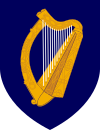
Back دستور أيرلندا Arabic Канстытуцыя Ірландыі Byelorussian Конституция на Ирландия Bulgarian Cyfansoddiad Iwerddon Welsh Verfassung von Irland German Σύνταγμα της Ιρλανδίας Greek Constitución de Irlanda Spanish Irlandako Konstituzioa Basque قانون اساسی ایرلند Persian Constitution de l'Irlande French
| Constitution of Ireland | |
|---|---|
 | |
| Overview | |
| Original title | Bunreacht na hÉireann |
| Jurisdiction | Republic of Ireland |
| Ratified | 1 July 1937 |
| Date effective | 29 December 1937 |
| System | Unitary parliamentary republic |
| Government structure | |
| Branches | |
| Head of state | President of Ireland |
| Chambers | Bicameral (Dáil Éireann and Seanad Éireann) |
| Executive | Government of Ireland |
| Judiciary | |
| History | |
| Amendments | 32 |
| Last amended | 11 June 2019 |
| Citation | Constitution of Ireland |
| Supersedes | Constitution of the Irish Free State |
| Full text | |
 |
|---|
The Constitution of Ireland (Irish: Bunreacht na hÉireann, pronounced [ˈbˠʊnˠɾˠəxt̪ˠ n̪ˠə ˈheːɾʲən̪ˠ]) is the fundamental law of Ireland. It asserts the national sovereignty of the Irish people. It guarantees certain fundamental rights, along with a popularly elected non-executive president, a bicameral parliament, a separation of powers and judicial review.
It is the second constitution of the Irish state since independence, replacing the 1922 Constitution of the Irish Free State.[1] It came into force on 29 December 1937 following a statewide plebiscite held on 1 July 1937. The Constitution may be amended solely by a national referendum.[2] It is the longest continually operating republican constitution within the European Union.[3]
- ^ "Constitution of Ireland Bunreacht Na hÉireann". The All-Party Oireachtas Committee on the Constitution. Archived from the original on 21 July 2011. Retrieved 24 August 2008.
- ^ Article 46(2)
- ^ Marie-Luce Paris 'Popular Sovereignty and the Use of the Referendum – Comparative Perspectives with Reference to France', University College Dublin, 2012